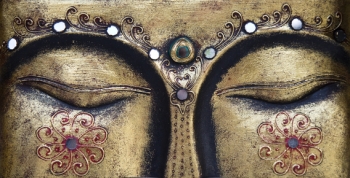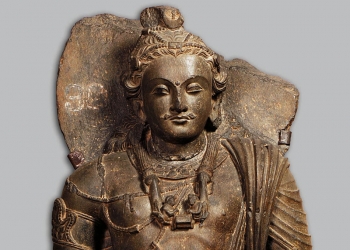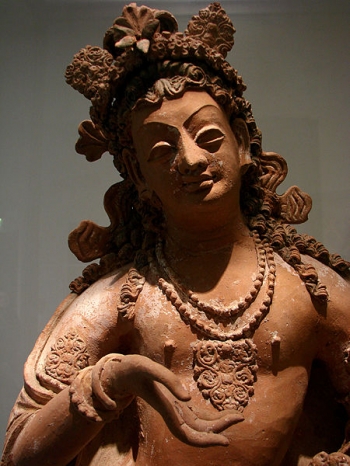Materialists claim that the physical world, which can be touched and measured, is the only reality that exists. But Buddhism sees the physical world as merely illusions arisen from creations of the mind. This physical world exists in order to be transcended, and is a valuable teacher in our spiritual training.
The Buddha said, ‘All things are preceded by the mind, led by the mind, created by the mind.’ As ordinary people, we always feel that we have to chase after external conditions (but not from within) to feel peaceful. For instance, in many religions, converts are attached to the ‘supreme being’ they believe in. They seek calmness and peace from an outside source by praying to whomever they find strength from. But if the Buddha is right, all experiences are generated by the mind. Therefore, if we seek calmness and peace, we have to look within ourselves. Our internal state of mind is not dependent upon its external environment.
The composition of an individual – the five aggregates
Buddhism believes that a person is a combined cluster of elements. There is no permanent entity as ‘a person’. It is merely a name for a combination of component parts: the 5 aggregates (Bodhi, 2007). They include body (matter), feeling, perception, mental formation and consciousness. Except for the body, the other four aggregates are related to the mind. Feeling, perception and mental formation are regarded as mental factors while the consciousness is the mind. We think of ourselves as having a permanent identity or ‘I’ because we identify to the moment-to-moment processes of changing phenomena.
All mental phenomena have mind as their forerunner. This means that the three mental factors of feeling, perception and mental formation have mind (consciousness) arising before them. Consciousness arises first but it does not arise alone; mental factors arise together with it (Bodhi, 2007). Mental factors also perish together with consciousness. Whenever we see the king (consciousness), we will see the servants (mental factors). When mind arises and cognizes an object, it is accompanied by several mental factors that help the mind in cognizing the object.
This is one quick illustration of how the five aggregates work together to generate an experience. When I see a one hundred dollar note on the floor, my eyes come into contact with a visible object (the note) and send electrical signals to the brain about what I see. The body is responsible for this part. Then, the signal or energy is picked up by the consciousness or mind. The physical part of the senses is in contact with the mental parts as the mind arises. So, the mind becomes associated with the visible object. After that, the mental factors turn this awareness of the visible object into a personal experience. Perception (one of the mental factors) tries to recognize and figure out what I just saw. Is it a paper, a handkerchief, or a banknote? At the same time, the mental factor of feeling comes into play. It evaluates the perception and decides whether it is pleasant, unpleasant or just neutral. When I recognize that it is a one hundred dollar banknote, I feel rather pleased. Based on what I feel and what I recognize the thing I saw to be, the mind creates mental formation which could be thoughts, projections and/or actions.
Mind (citta) and Mental Factors (cetasikas)
Citta and cetasikas are two kinds of paramattha dhammas, or fundamentally real entities (Bodhi, 2007). They cannot be separated as they arise and fall away together with each and every moment in our daily life. The cetasikas share the same focus as the citta does as they have the same physical base. There are 52 mental factors according to the classification of the Abhidhamma, and not all of them arise together with the citta. But there are at least seven universal mental factors that are following each moment of citta, including: contact, sensations (feeling), perception, volition (will or intention), one pointedness (concentration), life faculty and attention. These seven mental factors provide the fundamental ground for cognitive functions.
A working example of this synergy is reading. When you’re reading this article, our eyes first come into contact with the letters on the screen. Citta becomes aware of the visual input on the screen. Then, perception recognizes the visual inputs as words that I have seen before. Feeling here can be neutral or unpleasant (maybe because my writing is not agreeable). Volition is the will or action of reading continually. Life faculty sustains one’s life in order for all these cognitions to happen. One-pointedness allows the reader to focus on the mind and the essay here. Attention directs the reader to the mind and article.
Types of cittas and the accompanying cetasikas
There are four cittas as classified by their nature (jati): akusala (unwholesome), kusala (wholesome), vipaka (result) and kiriya (neither the cause nor the result). The cetasikas that accompany the rise of citta depend on the nature of the citta.
When an akusala citta arises, some akusala cetasikas will follow. By the same reasoning, sobhana-sadharana cetasikas accompany the arising of kusala citta. For example, when one shows generosity by donating money, it means that aloba (one of the beautiful cetasikas), which is the non-attachment to objects, has arisen.
Objects, doorways and consciousness
Physical elements (colors, smell, touch, hearing) alone cannot produce an experience. As I am writing this article, I pay no attention to the ‘tick-tock’ sound of the clock. My ears have been exposed to that sound for an hour until I come to realize that as there is sound from the clock. Consciousness is therefore an essential part in producing an experience.
Although people live in the same block of building near a busy road, they may react very differently to the traffic noise. Some find the traffic noise very annoying while others find that the noises do not bother them at all. This is because of citta. Every moment we receive millions of signals from our sense organs. We see things, we hear things and we touch things. However, citta does not come into contact with every signal. So, residents are aware of the noise because of the citta. As citta cognizes the sound waves, the seven universal mental factors must arise. With the perception that the sound waves are traffic noise, unpleasant feeling is generated simultaneously (but some might have neutral feeling). For others, the object is there and the door is there, but the consciousness is missing. Therefore, there is no contact and no awareness.
Moment to moment changes – the impermanence of nature
Citta and Cetasikas never last. One citta only lasts for 17 thought moments and then the next citta arises, accompanied by a different set of cetaikas depending on the types of citta (wholesome or unwholesome). However, if citta does not last, how can the pleasant or unpleasant feelings generated by the collective efforts of citta and cetasikas last? This is due to ignorance and attachment.
For example, when we help an old lady crossing the road on the street, the altruistic behavior is accompanied by a satisfied feeling that can last longer than the event itself. It can be a few minutes or hours. We do not know but we can be sure that it lasts longer than 17 thought moments! But the feeling of happiness in this whole period is not considered as a wholesome one. As the kusala citta arises, citta is cognizing the behavior and perception discriminates it as altruistic. As a result, a happy feeling is generated. The happy feeling generated in this citta is a wholesome one. As this citta falls away, the next citta arises and it maybe cognizing something different from the previous citta. The new arising citta can cognize the attachement to the previous object and attach to the previous feeling. This extends the feeling of happiness. Cetasikas such as moha and lobha accompany the arising of the new citta. Moha is the ignorance that blinds us from seeing the true nature of things: impermanence, non-self and suffering.
When right insight and understanding including impermanence has not been gained, we cannot distinguish between the cittas and the objects experienced. As we do not realize that citta arises and falls away quickly, we mistake this series of momentary experiences with a permanent self.
Conclusion
The study of citta and cetasikas allows us to understand more thoroughly the operation of the mind. It is important to apply the vital implications of this somewhat dry epistemology and recognize the wholesome and unwholesome factors as they arise. After we start recognizing these cittas and cetasikas, we should strive to abandon the unwholesome ones that have arisen and prevent the unarisen ones from arising (Bodhi, 2007). As for the wholesome ones, we should strive to produce more of the ones that have not arisen and nurture the ones that have already arisen. Take it far enough, and the end of suffering will be ever so closer.
References
Bodhi, B. (2007). A Comprehensive Manual of Abhidhamma. Buddhist Publication Society. Kandy: Sri Lanka.
Wisdom Library (2001). Retrieved December 22, 2012, from http://www.wisdomlib.org/buddhism/book/abhidhamma-in-daily-life/d/doc2708.html


















